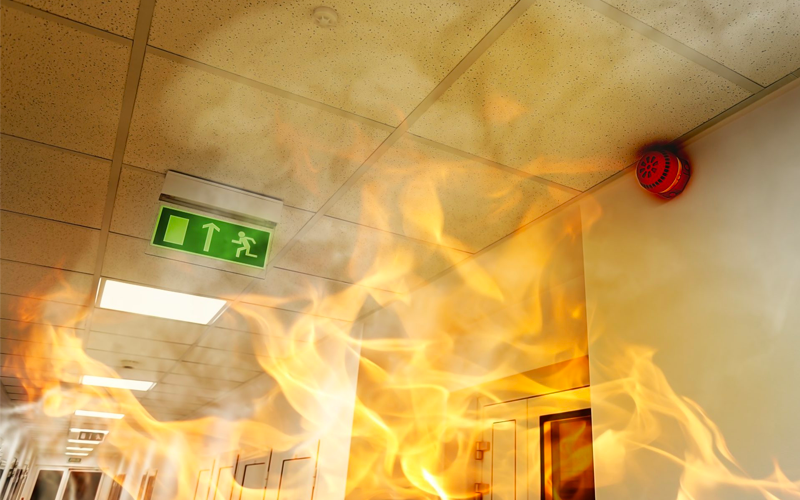One of the key strategies to maintaining a safe workplace and preventing fires is fire safety training. With proper training workers can eliminate fire hazards and respond quickly and efficiently if a fire breaks out.
Every workplace has its own specific fire risks, and in turn should therefore have in place its own preventative measures and carefully honed procedures in order to combat these unique threats.
But whether you work in a factory or in an office, in a garage or a care home, there are still some basic tips which everyone should follow to maintain fire safety in the workplace.
Here are 10 Ways to keep your workplace safe
1. Good Housekeeping.
A clean and tidy workplace helps combat a range of different threats, and if your workplace handles a lot of flammable material this could be the difference between a minor threat and a catastrophic blaze. Whether you’re dealing with oily rags or stacks of paper filing, make sure everything is stored safely and away from naked flames.
2. Maintain electrical safety.
A huge number of fires in workplace premises can be traced back to faulty wiring and electrical equipment. If your team contains someone qualified to repair electrical equipment, ensure they keep on top of any known issues. If not, book in regular inspections and PAT testing to avoid the risk of electrical fire. You should also maintain the safe operation of your site’s equipment, and prevent overheating or sparking wherever possible. Unless you are qualified and authorized, you should never attempt electrical repairs. Faulty wiring and malfunctioning electrical equipment are key contributors to workplace fires. If you notice something does not look right, immediately notify the proper person in your facility.
3. Accessibility.
 If there is an emergency and you need to shut down a particular machine, the last thing you want to be doing is shifting boxes or equipment out of the way before you can even get to the control panel. Keep a clear line of access and sight to any control panels within your premises, and preferably have them visibly marked to enable swift identification at a moment’s notice. Also, never block sprinklers, firefighting equipment or emergency exits and observe clearances when stacking materials.
If there is an emergency and you need to shut down a particular machine, the last thing you want to be doing is shifting boxes or equipment out of the way before you can even get to the control panel. Keep a clear line of access and sight to any control panels within your premises, and preferably have them visibly marked to enable swift identification at a moment’s notice. Also, never block sprinklers, firefighting equipment or emergency exits and observe clearances when stacking materials.
4. Fire Drills and Evacuation Plan.
Conduct fire drills at least twice a year and have a designated spot where employees will meet once they exit the building. Assign employees to be fire drill captains and make sure everyone knows what the proper procedure is. Review your plan with your local fire company to assess its effectiveness. One of the most important parts of fire safety training concerns exit procedures in the event of fire. Make fire drills a regular part of your workplace schedule, and ensure that your employees treat each one with the respect it deserves. You may also wish to appoint a dedicated fire marshal to oversee the correct observance of every fire drill, and ensure that any employees who disregard its importance are re-educated in fire safety to prevent further lapses.
5. Fit relevant equipment.
 Smoke alarms should be fitted throughout your building and tested at regular intervals, with their batteries replaced annually. You should also make sure that you have the right fire-fighting equipment relevant to the threats present in every room. Different types of fire require vastly different approaches in order to tackle them effectively, so as part of your fire safety training ensure that your staff not only have access to the right kind of extinguisher, but that they also know how to use them.
Smoke alarms should be fitted throughout your building and tested at regular intervals, with their batteries replaced annually. You should also make sure that you have the right fire-fighting equipment relevant to the threats present in every room. Different types of fire require vastly different approaches in order to tackle them effectively, so as part of your fire safety training ensure that your staff not only have access to the right kind of extinguisher, but that they also know how to use them.
6. Fully Charged Fire Extinguishers.
Check fire extinguishers often by looking at the gauges and making sure they’re fully charged and ready for use. If they’re not fully charged or if the attached tag indicates that the last inspection occurred more than a month ago, call for maintenance. Also, encourage all workers to learn how to use a fire extinguisher and provide the proper training.
7. Maintain Fire Safety Training.
A team of educated and observant employees is your biggest ally in achieving fire safety for the workplace. Knowing the best course of action in an emergency can help prevent major disasters and unnecessary loss of life and infrastructure, therefore it is imperative that all employees, both new and old; are retrained in your workplace’s fire safety procedures as often as possible.
8. Store Chemicals Safely.
Many workplaces might not feel this particular point applies to them, but flammable chemicals can be found in most workplaces. This could be in the form of printing supplies and the products stocked in your cleaner’s cupboard. Follow all documented advice which comes on both the label and any material safety data sheets you may have for these items. Make sure your employees have the proper protective equipment for handling hazardous materials.
9. Building security.
To help prevent arson fires, always lock up as instructed and report suspicious persons or behaviour. Never leave combustible waste outside or near your building.
10. Emergency Numbers and Proper Signage.
Emergency phone numbers, as well as your company address, should be posted by the phone station for quick access. If necessary, create additional information sheets in the native languages for your employees. Make sure you have exit signs installed in your facility. In addition to this, a fire evacuation plan in the event of an emergency.
At Ajuda, we run regular First Safety Courses at our Training Academy in Cardiff Bay, or we can come to you to deliver in house training at your premises.
To find about more about Fire Safety, contact us at Ajuda Training on 02920 576 883 or visit us at ajuda.org.uk









